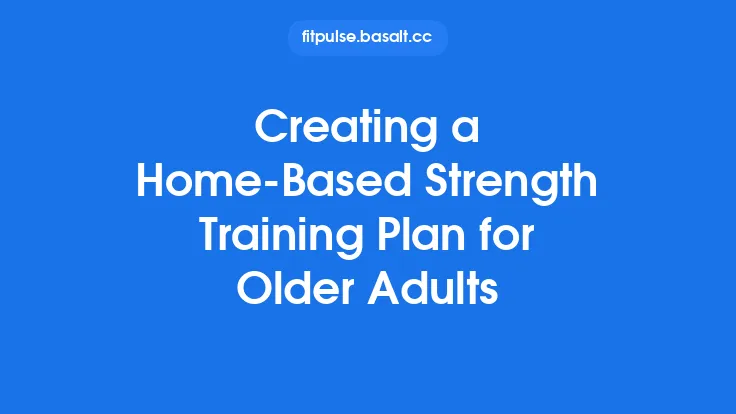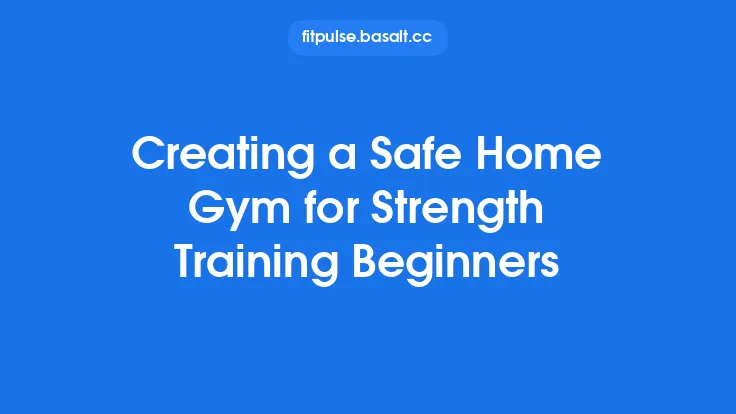Creating a supportive calisthenics community at home is about more than just sharing a workout space—it’s about fostering an environment where motivation, knowledge, and encouragement flow freely among participants. When the right social infrastructure is in place, individual progress accelerates, adherence improves, and the practice becomes a sustainable lifestyle choice. Below is a comprehensive guide to building, nurturing, and maintaining a thriving home‑based calisthenics community.
Defining the Community’s Purpose and Values
Clarify the mission
Start by articulating a clear, concise mission statement. This could be as simple as “to empower each member to achieve personal strength goals through collaborative bodyweight training.” A well‑defined purpose helps attract like‑minded individuals and sets expectations for behavior and commitment.
Establish core values
Values act as the cultural glue. Common pillars for a calisthenics community include:
- Respect: Honor each person’s current skill level and personal limits.
- Inclusivity: Welcome participants of all ages, genders, and fitness backgrounds.
- Growth Mindset: Emphasize learning, experimentation, and constructive feedback.
- Safety: Prioritize proper technique and injury prevention.
- Accountability: Encourage regular check‑ins and honest progress reporting.
Document these values in a shared file (Google Docs, Notion, etc.) and revisit them periodically to ensure they remain relevant.
Recruiting the Right Members
Identify potential participants
Look for individuals who already have an interest in bodyweight training—family members, roommates, neighbors, or friends from online forums. Even those who are beginners can add value by bringing fresh perspectives and enthusiasm.
Use a simple onboarding questionnaire
Collect basic information such as:
- Current training experience (none, beginner, intermediate, advanced)
- Primary goals (strength, skill acquisition, mobility)
- Preferred training times and frequency
- Any physical limitations or injuries
This data helps you design sessions that accommodate diverse needs and prevents mismatched expectations.
Set clear expectations from the start
Share a brief “Community Charter” that outlines attendance expectations, communication etiquette, and the process for requesting or offering assistance. Transparency reduces friction later on.
Structuring the Training Sessions
Create a flexible schedule
A rotating schedule (e.g., three evenings per week) works well for most households. Offer a mix of:
- Skill‑focused sessions (e.g., handstand progressions)
- Strength circuits (e.g., push‑up variations, pistol squats)
- Mobility & warm‑up workshops (to reinforce safe movement patterns)
Allow members to sign up for specific slots via a shared calendar (Google Calendar, Outlook) to avoid double‑booking and to give everyone a sense of ownership.
Design a session template
A repeatable structure keeps meetings efficient:
- Check‑in (5 min): Quick round‑robin where each person shares a win or a challenge.
- Warm‑up (10 min): Joint mobility drills that address common calisthenics prerequisites.
- Skill/Strength Block (30 min): Split into stations or partner drills, rotating every 5–7 minutes.
- Cool‑down & Reflection (5 min): Stretching followed by a brief discussion of what worked and what needs adjustment.
Having a template reduces planning overhead and ensures each session covers the essential components.
Leverage progressive overload as a group tool
Introduce a simple tracking system—such as a shared spreadsheet—where each member logs reps, sets, and difficulty level for core movements (e.g., push‑ups, dips, rows). Use the data to:
- Identify when a participant is ready to increase difficulty (e.g., moving from knee push‑ups to standard).
- Create “challenge weeks” where the community collectively adds a set or a rep to a chosen exercise.
This data‑driven approach keeps progress measurable and encourages friendly competition.
Communication Channels
Primary hub
Choose a platform that everyone is comfortable with—Discord, Slack, or a private Facebook group. Set up dedicated channels for:
- Announcements (schedule changes, upcoming events)
- Progress Logs (members can post weekly updates)
- Technique Q&A (share videos, ask for form critiques)
- Social (non‑training chat to build camaraderie)
Asynchronous updates
Encourage members to post short video clips of their practice. This allows peers to provide feedback without needing everyone to be present at the same time.
Emergency protocol
Establish a simple rule: if anyone feels pain or suspects injury, they must immediately notify the group and cease the activity. Having a clear line of communication for safety concerns reinforces trust.
Fostering Mentorship and Peer Learning
Identify natural mentors
Within the group, some members will have more experience in specific skills (e.g., muscle‑ups, planches). Pair them with less experienced participants for focused mini‑sessions. Formalize this by creating a “Mentor‑Mentee” roster that rotates every quarter, ensuring knowledge spreads throughout the community.
Skill‑share workshops
Dedicate one session per month to a deep dive on a particular movement. The mentor demonstrates progressions, explains common pitfalls, and leads participants through a guided practice. Record the workshop for future reference.
Feedback loops
Teach members how to give constructive feedback using the “SBI” model (Situation‑Behavior‑Impact). For example: “During the handstand hold (Situation), you tucked your hips (Behavior), which made the balance less stable (Impact). Try engaging your core more.” Structured feedback reduces misunderstandings and promotes growth.
Celebrating Milestones
Public acknowledgment
When a member achieves a new skill (first full push‑up, first handstand hold, etc.), announce it in the primary hub and celebrate with a small “badge” or emoji. Recognition reinforces effort and motivates others.
Community challenges
Organize quarterly challenges—e.g., “30‑day pull‑up progression” or “Weekly max‑hold contest.” Publish a leaderboard (optional) and reward the top performers with non‑material incentives like a custom workout playlist or a featured spot in the community newsletter.
Progress showcase events
Host a virtual “Show‑and‑Tell” where each participant demonstrates a skill they’ve improved over the past month. This not only celebrates achievements but also provides visual learning for the group.
Managing Conflict and Maintaining a Positive Atmosphere
Set ground rules for discourse
Reiterate the community values in the communication hub’s pinned post. Emphasize that criticism should focus on technique, not the individual, and that personal attacks are prohibited.
Conflict resolution process
If a disagreement arises:
- Private discussion: The involved parties talk one‑on‑one, preferably with a neutral mentor present.
- Mediation: If unresolved, a designated “Community Moderator” (rotating role) facilitates a group discussion.
- Resolution: Agree on actionable steps and document them in the shared notes.
Having a transparent process prevents resentment and keeps the focus on collective growth.
Integrating Family and Non‑Athlete Members
Inclusive warm‑ups
Design a short, low‑impact warm‑up that anyone can join (e.g., dynamic stretching, light cardio). This invites family members who may not be training seriously to participate and feel part of the routine.
Skill‑level stations
During the strength block, set up multiple stations with varying difficulty. For example:
- Station A: Assisted pull‑ups with a resistance band (beginners)
- Station B: Standard pull‑ups (intermediate)
- Station C: Weighted pull‑ups (advanced)
Participants can rotate through stations appropriate to their level, fostering a sense of progression without pressure.
Family challenge days
Occasionally schedule a “Family Fun Day” where the focus shifts to cooperative games (e.g., partner plank holds, relay circuits). This strengthens bonds and demonstrates that calisthenics can be a shared, enjoyable activity.
Leveraging Technology for Community Growth
Video analysis tools
Encourage members to use free apps (Coach’s Eye, Hudl Technique) to record and annotate their movements. Sharing annotated clips in the community hub provides visual feedback that is more precise than text alone.
Progress tracking apps
Adopt a simple, shared platform like Google Sheets or Notion to log workouts, reps, and skill milestones. Use conditional formatting to highlight when a member reaches a predefined threshold (e.g., 10 consecutive pull‑ups), triggering an automatic celebration notification.
Virtual meet‑ups
When physical attendance is impossible, schedule live video sessions via Zoom or Google Meet. Use breakout rooms for partner drills, allowing participants to practice together even when apart.
Scaling the Community Over Time
Gradual expansion
Start with a core group of 3‑5 members. As the community stabilizes, invite additional participants through word‑of‑mouth or a simple “Open Invite” post in the hub. Keep the growth rate manageable to maintain quality interaction.
Formalize roles
As numbers increase, assign rotating responsibilities:
- Session Coordinator: Plans the weekly agenda.
- Tech Lead: Manages the communication platform and troubleshooting.
- Safety Officer: Oversees warm‑up protocols and injury reporting.
Rotating roles prevent burnout and give everyone a sense of ownership.
Create sub‑groups
If the community reaches 15+ members, consider forming sub‑groups based on skill focus (e.g., “Handstand Circle,” “Pull‑up Progression Squad”). Sub‑groups meet more frequently for specialized work while still participating in the larger community’s general sessions.
Measuring Success
Quantitative metrics
- Attendance rate: Percentage of scheduled sessions attended per month.
- Progress logs: Average increase in reps/sets or skill level across members.
- Engagement: Number of posts/comments per week in the communication hub.
Qualitative feedback
- Conduct a quarterly anonymous survey asking members about satisfaction, perceived support, and suggestions for improvement.
- Hold a brief “pulse check” at the end of each session where participants rate the experience on a 1‑5 scale.
Use these data points to adjust scheduling, content, and community policies, ensuring the environment remains responsive to members’ evolving needs.
Final Thoughts
A home‑based calisthenics community thrives on intentional design, clear communication, and a shared commitment to growth. By establishing a purpose‑driven culture, structuring sessions that respect diverse skill levels, and leveraging simple technological tools, you can transform a modest living space into a vibrant hub of mutual encouragement and measurable progress. The result is not just stronger bodies, but a resilient network of individuals who lift each other—both literally and figuratively—toward their personal best.





